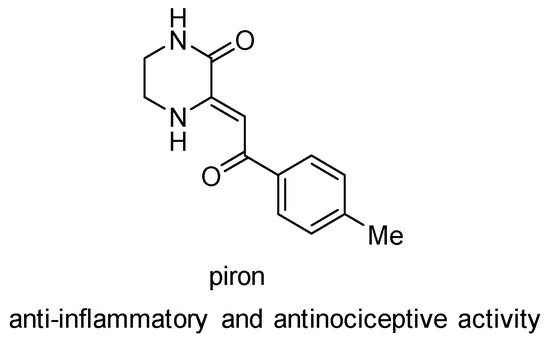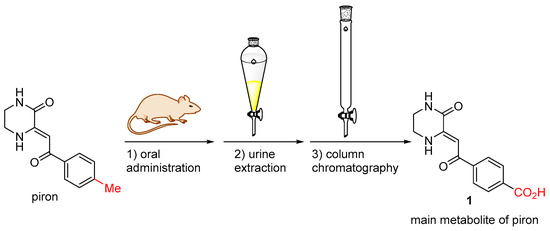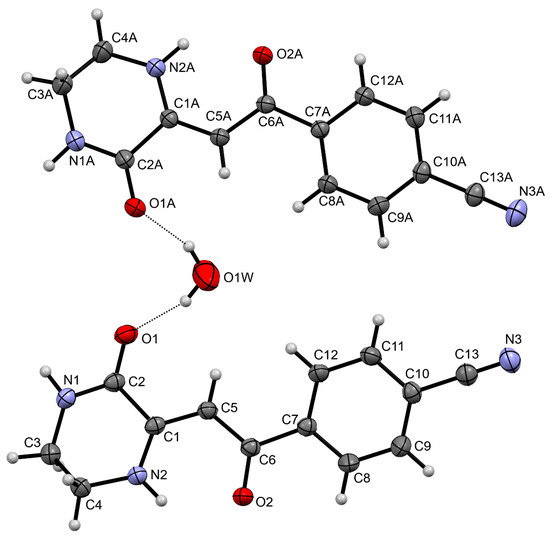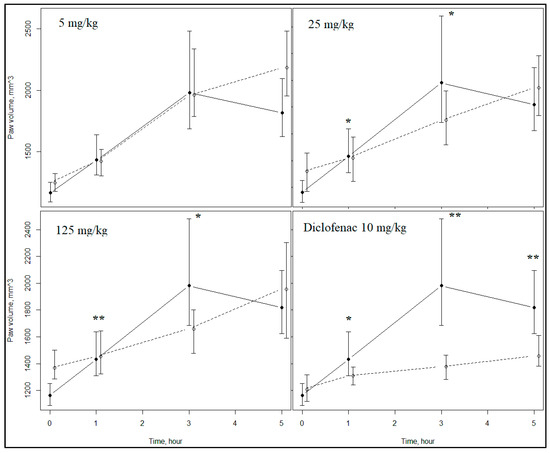Abstract
Non-steroidal anti-inflammatory drugs (NSAIDs) are an important class of medications; however, they have some drawbacks. We are developing a new NSAID with pronounced anti-inflammatory and analgesic activities and a very low toxicity—(Z)-3-(2-oxo-2-(p-tolyl)ethylidene)piperazin-2-one (piron). In this work, we describe the synthesis of the main metabolite of piron—(Z)-4-(2-(3-oxopiperazin-2-ylidene)acetyl)benzoic acid. The anti-inflammatory activity of the synthesized metabolite was determined in vivo.
1. Introduction
Non-steroidal anti-inflammatory drugs (NSAIDs) are one of the most popular classes of medications. However, currently used drugs bear some drawbacks such as gastrointestinal, cardiovascular, hepatic, renal, and other complications [1,2]. (Z)-3-(2-Oxo-2-(p-tolyl)ethylidene)piperazin-2-one (piron, Figure 1) is an NSAID with pronounced anti-inflammatory and analgesic activities that we are developing [3,4]. Piron exhibits a very low toxicity compared to NSAIDs such as ibuprofen and diclofenac sodium, and it also does not show an ulcerogenic effect [3].

Figure 1.
The structure of (Z)-3-(2-oxo-2-(p-tolyl)ethylidene)piperazin-2-one (piron).
In the course of studying the pharmacokinetic behavior of piron in rats, we discovered that its metabolite 1 was present in the blood in a concentration comparable with piron and gave the main contribution to its excretion. We successfully isolated the metabolite 1 (Scheme 1) from rat urine and determined its structure. The methyl group of piron was found to be oxidized to a carboxyl group in the body, which apparently reduces the lipophilicity of piron and accelerates its excretion. In the present work, we wish to report the synthesis of piron metabolite 1 and the study of its anti-inflammatory activity.

Scheme 1.
Metabolic oxidation of piron to its metabolite 1.
2. Results and Discussion
2.1. Chemistry
We tested several strategies to synthesize piron metabolite 1 (Scheme 2). Initially, we tested the most obvious approach—direct oxidation of piron (CCDC 2314647, Figure 2) under the action of oxidizing agents such as KMnO4 and H2O2 (Scheme 2, strategy 1). Unfortunately, this strategy was not successful.

Scheme 2.
Three synthetic routes to piron metabolite 1 (strategy 1 was reported earlier in [3]).

Figure 2.
Molecular structure of (Z)-3-(2-oxo-2-(p-tolyl)ethylidene)piperazin-2-one (piron) showing 30% probability for amplitude displacement ellipsoids.
Then, we examined another synthetic pathway (Scheme 2, strategy 2) using 4-acetylbenzonitrile as the starting reagent for the Claisen condensation. The Claisen condensation of 4-acetylbenzonitrile with diethyl oxalate in the presence of sodium methoxide successfully yielded p-cyanobenzoylpyruvic ester 2 (Scheme 2). The cyclocondensation of the latter with ethylenediamine led to the formation of cyano analog 3 of piron whose structure was confirmed through a single-crystal X-ray analysis (CCDC 2314648, Figure 3). Next, we tested different conditions for the hydrolysis of the cyano group in compound 3. Hydrolysis in an aqueous acidic medium (HCl or H2SO4) destroyed compound 3, resulting in 4-acetylbenzonitrile. Alkaline hydrolysis (NaOH in water and dioxane) was also unsuccessful. Anhydrous conditions similar to the Pinner reaction (HCl in MeOH) also led to the degradation of the molecule to methyl 4-acetylbenzoate.

Figure 3.
Molecular structure of compound 3 showing 30% probability for amplitude displacement ellipsoids. An asymmetric unit is shown.
Due to difficulties encountered in performing selective hydrolysis of the cyano group, we turned to strategy 3, starting from 4-acetylbenzoic acid (Scheme 2, strategy 3). Fortunately, both stages of the synthesis (Claisen condensation of 4-acetylbenzoic acid and reaction of compound 4 with ethylenediamine) proceeded smoothly to form carboxy analog 1 of piron (Scheme 2). The structure of compound 1 was confirmed by the 1H and 13C NMR spectra and was identical to the structure of the piron metabolite isolated from animal urine.
2.2. X-ray Analysis
The crystal structure of piron has not been previously studied using X-ray diffraction. Since knowledge of the structural features for bioactive compounds may be useful, we performed a single-crystal X-ray analysis of piron. It crystallizes in the centrosymmetric space group of C2/c (Figure 2). The molecule, except for two methylene groups, is approximately planar (RMSD 0.048 Å). Methylene groups deviate from the plane of the piperazine ring in opposite directions; in other words, the ring is in a half-chair conformation. Due to the planarity of the molecule, the enaminoketone moiety contains an intramolecular hydrogen bond N2–H2∙∙∙O2 (Table 1). Intermolecular hydrogen bonds N1–H1∙∙∙O1 link molecules in a crystal into centrosymmetric dimers (Figure 4).

Table 1.
Hydrogen bond geometry.

Figure 4.
Dimer in crystal of piron.
Compound 3 crystallizes in the centrosymmetric space group P21/c as a hydrate. The asymmetric unit contains 2 geometrically similar molecules of compound 3 and a water molecule (Figure 3). The structure of compound 3 is generally similar to the structure of piron. Both independent molecules 3 are also relatively planar. However, the aryl rings in them are slightly rotated relative to the enaminoketone moiety (RMSD 0.135 Å and 0.071 Å for non-hydrogen atoms in compound 3, excluding two methylene groups). Intramolecular hydrogen bonds N2–H2∙∙∙O2 and N2A–H2A∙∙∙O2A are formed similarly to piron (Table 1). Dimers in a crystal are formed from independent molecules 3 via intermolecular hydrogen bonds N1A—H1A···O1 and N1—H1···O1A (Table 1). These dimers are linked through H-bonding with water molecules into infinite chains along the 0c axis (Figure 5).

Figure 5.
Formation of a chain from dimers of compound 3 in a crystal.
2.3. Biological Assay
The anti-inflammatory activity of compound 1 was assessed in white laboratory outbred rats through a carrageenan-induced paw edema test (intraperitoneal administration in doses of 5, 25, and 125 mg/kg). Compound 1 was found to show anti-inflammatory activity in doses of 25 and 125 mg/kg at time periods of 1 and 3 h after administration of the inflammation inducer (Table 2, Figure 6), suppressing the development of edema (edema inhibition 48.9–63.1%). The activity of compound 1 was comparable to the activity of diclofenac, which was used as a positive control (Table 2, Figure 6). The level of anti-inflammatory activity of piron [5] and its metabolite 1 was also comparable. To determine the leader compound in this pair, a separate parallel experiment is required.

Table 2.
Inhibition of edema relative to the values of the control group.

Figure 6.
Dynamics of paw edema. The dots indicate the average values, the whiskers indicate the boundaries of the 95% confidence interval, the continuous line with black dots shows the dynamics of edema in the control group, and the dotted line with white dots shows the dynamics of edema in the experimental group. *—p-value ≤ 0.1, **—p-value ≤ 0.05.
3. Materials and Methods
3.1. General Information
1H and 13C NMR spectra (Supplementary Materials) were acquired on a Bruker Avance III 400 HD spectrometer (Bruker BioSpin AG, Faellanden, Switzerland) (at 400 and 100 MHz, respectively) in CDCl3 or DMSO-d6 using the solvent residual signal (DMSO-d6: δH = 2.50 ppm; δC = 39.52 ppm; CDCl3: δH = 7.26 ppm; δC = 77.16 ppm) as an internal standard. IR spectra were recorded on a Perkin Elmer Spectrum Two Spectrometer (PerkinElmer Inc., Waltham, MA, USA) as mulls in mineral oil. Melting points were measured on a Mettler Toledo MP70 Melting Point apparatus (Mettler-Toledo (MTADA), Schwerzenbach, Switzerland). Elemental analysis was carried out on a Vario MICRO Cube analyzer (Elementar Analysensysteme GmbH, Langenselbold, Germany). TLC was performed on plates Silica gel 60 F254 (Merck, Darmstadt, Germany); spots were visualized with UV light (254 nm). Silica gel 0.035–0.070 mm, 60 Å (Acros Organics, Geel, Belgium), was used for column chromatography. The single-crystal X-ray analysis of piron and compound 3 was performed on an Xcalibur Ruby diffractometer (Agilent Technologies, Wroclaw, Poland). The empirical absorption correction was introduced via multi-scan method using SCALE3 ABSPACK algorithm [6]. Using OLEX2 [7], the structures were solved with the SHELXS [8] or SHELXT [9] programs and refined by the full-matrix least-squares minimization in the anisotropic approximation for all non-hydrogen atoms with the SHELXL [10] program. Hydrogen atoms bound to carbon were positioned geometrically and refined using a riding model. The hydrogen atoms of NH groups were refined freely with isotropic displacement parameters. Crystal structures of piron and compound 3 were deposited at the Cambridge Crystallographic Data Centre with the deposition numbers CCDC 2314647 (piron) and 2314648 (compound 3). Piron was obtained according to the reported procedure [3]. All solvents and reagents were purchased from commercial vendors and used as received.
3.2. Methyl (Z)-4-(4-cyanophenyl)-2-hydroxy-4-oxobut-2-enoate 2
To a solution of sodium methoxide freshly prepared from 160 mg of sodium and methanol (3 mL), a solution of diethyl oxalate (1.01 g, 6.9 mmol) and 4-acetylbenzonitrile (1 g, 6.9 mmol) in methanol (2 mL) was added. The reaction mass was left at room temperature overnight, and an excess of 1M HCl (8 mL) was added. The resulting suspension was stirred for 3 h at room temperature; the precipitate was filtered off and recrystallized from ethanol to yield title compound 2. Yield: 0.90 g (56%); white solid; mp 170–175 °C (lit. 161–163 °C [11]). IR (cm–1): 2228, 1733, 1615. 1H NMR (400 MHz, Chloroform-d) δ: 14.97 (br. s, 1 H), 8.08 (d, J = 8.8 Hz, 2 H), 7.80 (d, J = 8.8 Hz, 2 H), 7.06 (s, 1 H), 3.96 (s, 3 H).
3.3. (Z)-4-(2-(3-Oxopiperazin-2-ylidene)acetyl)benzonitrile 3
Ethylenediamine (286 µL, 4.3 mmol) was added to a solution of compound 2 (900 mg, 3.9 mmol) in ethanol (10 mL) and acetic acid (2 mL), and the reaction mixture was heated at reflux for 2 h. Then, the reaction mixture was cooled to room temperature. The formed precipitate was filtered off and recrystallized from the mixture of ethanol and chloroform to yield title compound 3. Yield: 600 mg (60%); yellow solid; mp 234–235 °C. IR (cm–1): 3204, 2227, 1691, 1602. 1H NMR (400 MHz, DMSO-d6) δ: 10.80 (s, 1 H), 8.58 (s, 1 H), 8.00 (d, J = 8.0 Hz, 2 H), 7.91 (d, J = 8.0 Hz, 2 H), 6.48 (s, 1 H), 3.59–3.34 (m, 4 H). 13C NMR (101 MHz, DMSO-d6) δ: 186.5, 159.2, 152.1, 143.0, 132.5 (2 C), 127.3 (2 C), 118.3, 113.3, 89.0, 38.8, 38.6. Anal. Calcd (%) for C13H11N3O2: C 64.72; H 4.60; N 17.42. Found: C 64.98; H 4.54; N 17.25.
3.4. (Z)-4-(3-Hydroxy-4-methoxy-4-oxobut-2-enoyl)benzoic Acid 4
Dimethyl oxalate (620 mg, 5.25 mmol) was added to a solution of sodium methoxide freshly prepared from 250 mg of sodium (10.9 mmol) and methanol (4 mL). 4-Acetylbenzoic acid was added to the reaction mass heated to 60 °C under stirring. The reaction mixture was heated at 40 °C overnight. The formed precipitate was filtered off and washed with petroleum ether (10 mL) and toluene (1.5 mL). Then, 1M HCl (15 mL) was added to the precipitate in a flask, and the resulting suspension was stirred for 1 h. The precipitate was filtered off and washed with water (10 mL) and petroleum ether (10 mL) to yield title compound 4. Yield: 970 mg (78%); white solid; mp 195–198 °C. IR (cm–1): 1752, 1687, 1619. Tautomer ratio ~ 9:1 (A:B). 1H NMR (400 MHz, DMSO-d6) δ (A + B): 13.28 (br. s, 0.9 H, A), 8.14 (d, J = 8.3 Hz, 2 H, A + B), 8.11–8.04 (m, 2 H, A + B), 7.12 (s, 0.9 H, A), 5.00 (br. s, 1 H, A + B), 4.64 (s, 0.2 H, B), 3.87 (s, 2.7 H, A), 3.79 (s, 0.3 H, B). 13C NMR (101 MHz, DMSO-d6) δ (A): 188.1, 169.9, 166.3, 161.9, 137.6, 135.1, 129.7 (2 C), 127.9 (2 C), 98.4, 53.0. Anal. Calcd (%) for C12H10O6: C 57.61; H 4.03. Found: C 57.47; H 4.15.
3.5. (Z)-4-(2-(3-Oxopiperazin-2-ylidene)acetyl)benzoic Acid 1
A solution of ethylenediamine (2.92 mL, 43.8 mmol) in ethanol (30 mL) was added dropwise over 15 min to a solution of compound 4 (11.0 g, 43.8 mmol) in ethanol (150 mL) and acetic acid (5 mL) at 60 °C, and the reaction mixture was heated at 60 °C under stirring for 24 h. Then, the reaction mixture was cooled to room temperature. The formed precipitate was filtered off and washed with ethanol (10 mL) and ethyl acetate (10 mL) to yield title compound 1. Yield: 10.0 g (87%); yellow solid; mp 279–282 °C. IR (cm–1): 3299, 1728, 1667, 1619. 1H NMR (400 MHz, DMSO-d6) δ: 10.74 (s, 1 H), 8.56 (s, 1 H), 8.02 (d, J = 8.4 Hz, 2 H), 7.95 (d, J = 8.5 Hz, 2 H), 6.51 (s, 1 H), 3.54–3.45 (m, 2 H), 3.44–3.37 (m, 2 H). A proton of OH group was extremely broad and was in a wide range of 9–14 ppm. 13C NMR (101 MHz, DMSO-d6) δ: 187.7, 167.1, 159.4, 151.6, 142.3, 134.3, 129.3 (2 C), 126.6 (2 C), 89.2, 38.7, 38.6. Anal. Calcd (%) for C13H12N2O4: C 60.00; H 4.65; N 10.76. Found: C 60.32; H 4.67; N 10.89.
Isolation of 1 from rat urine: 50 mL of rat urine collected after oral administration of piron was extracted twice with ethyl acetate (2 × 50 mL). The organic extract was washed with H2O (3 × 30 mL) and brine, and it was dried over Na2SO4. The solvent was evaporated under reduced pressure. The residue was subjected to column chromatography (acetone–MeOH = 10:1, Rf 0.35) to yield compound 1 as a yellow solid.
3.6. Biological Assay
White laboratory outbred Wistar rats were used in the experiment. Animal preparation included selection by sex, age, and health status. Within the selected subpopulation, a random selection was performed, using a random number generator, into experimental groups of 6 animals (3 experimental (dose) groups, 1 control, 1 reference group) [12]. Animals in groups were marked using the method of applying end-to-end individual marks. The quality of randomization was checked by testing the significance of mass shifts and homogeneity of variances—before the experiment.
Test compound 1 was suspended in a 2% solution of food starch and administered intraperitoneally to animals in doses of 5 mg/kg, 25 mg/kg, and 125 mg/kg 40 min before subplantar injection of a 1% solution of carrageenan. Diclofenac 0.05 g tablets, enteric-coated (Ozon LLC, Zhigulevsk, Russia) were used as a reference. As an equistress treatment, animals in the control group were administered a 2% starch solution.
The edema inducer was a 1% solution of gamma-carrageenan (Sigma Aldrich, Burlington, MA, USA). The model of exudative inflammation, carrageenan paw edema, was modeled according to methods published in this field of research [13,14]. Paw measurements were performed using the oncometric photometric method. The photometry setup is a digital anhydrous plethysmometer. The plethysmometer uses an optical three-dimensional measurement system that calculates paw volume based on images from multiple digital cameras [15].
The anti-inflammatory effect was assessed by reducing the volume of edema in the experimental groups compared to the control group. To assess the anti-inflammatory activity of substances, the following indicators were used: the percentage of edema increase and the percentage of edema inhibition.
To process experimental data, nonparametric statistical methods were used in all cases where the requirements for parametric data were not met [16]. The main methods of data processing were various implementations of univariate and multivariate analysis of variance, including those resistant to outliers [17]. In this case, the nonparametric Wilcoxon method was used [18], and corrections for multiple comparisons were not performed. The exclusion of outliers was carried out according to the “1.5 IQR” rule [19,20].
The experimental plan of studies involving animals was agreed upon and approved by the ethics committee at the Department of Chemistry of Perm State University.
4. Conclusions
A method was developed for the synthesis of two new 3-oxopiperazin-2-ylidenes, including 3-oxopiperazin-2-ylidene 1, which is a metabolite of piron exhibiting anti-inflammatory activity. Compound 1 was found to exhibit anti-inflammatory activity comparable to the activity of diclofenac.
Supplementary Materials
The following supporting information can be downloaded online. Table S1: Crystal data and structure refinement for piron and compound 3; Figure S1: 1H NMR spectrum of compound 2; Figure S2: 1H NMR spectrum of compound 3; Figure S3: 13C NMR spectrum of compound 3; Figure S4: 1H NMR spectrum of compound 4; Figure S5: 13C NMR spectrum of compound 4; Figure S6: 1H NMR spectrum of compound 1; Figure S7: 13C NMR spectrum of compound 1.
Author Contributions
Conceptualization, I.V.M. and A.N.M.; methodology, E.E.K., M.V.D., A.N.M. and D.Y.A.; validation, E.E.K., M.V.D., A.N.M. and A.I.A.; investigation, E.E.K., M.V.D. (chemistry), D.Y.A., A.I.A. and I.I.K. (biological assay); writing—original draft preparation M.V.D., E.E.K. and D.Y.A.; writing—review and editing, M.V.D., E.E.K. and D.Y.A.; visualization, M.V.D., E.E.K. and D.Y.A.; supervision, I.V.M. and A.N.M.; project administration, I.V.M. and A.N.M.; funding acquisition, I.V.M. All authors have read and agreed to the published version of the manuscript.
Funding
This study was performed under financial support by the Perm Research and Educational Center “Rational subsoil use”.
Data Availability Statement
The presented data are available in this article and supporting information. Primary data are available on request from the corresponding author. Crystallographic data can be obtained free of charge from The Cambridge Crystallographic Data Centre via www.ccdc.cam.ac.uk/structures.
Conflicts of Interest
The authors declare no conflicts of interest.
References
- Bindu, S.; Mazumder, S.; Bandyopadhyay, U. Non-steroidal anti-inflammatory drugs (NSAIDs) and organ damage: A current perspective. Biochem. Pharmacol. 2020, 180, 114147. [Google Scholar] [CrossRef] [PubMed]
- Cooper, C.; Chapurlat, R.; Al-Daghri, N.; Herrero-Beaumont, G.; Bruyère, O.; Rannou, F.; Roth, R.; Uebelhart, D.; Reginster, J.Y. Safety of oral non-selective non-steroidal anti-inflammatory drugs in osteoarthritis: What does the literature say? Drugs Aging 2019, 36, 15–24. [Google Scholar] [CrossRef] [PubMed]
- Makhmudov, R.R.; Kotegov, V.P.; Andrejchikov, J.S.; Pidemskij, E.L. Anti-inflammatory and/or antinociceptive (Z)-3-(2-oxo-2-(4-tolyl) ethylidene)piperazine-2-on, method for production thereof, pharmaceutical compositions. Patent RU2602500, 20 November 2016. [Google Scholar]
- Mashevskaya, I.V.; Kotegov, V.P.; Makhmudov, R.R.; Suldin, A.S.; Puchnina, S.V. Composition and method for producing a solid dosage form containing (Z)-3-(2-oxo-2-(4-tolyl)ethylidene)piperazin-2-one. Patent RU2657526, 14 June 2018. [Google Scholar]
- Kotegov, V.P.; Razumova, M.Y.; Andreev, A.I.; Apushkin, D.Y. Study of the specific activity of piron on a model of carrageenan inflammation. In Proceedings of the “Creation of Competitive Medicines—A Priority Direction in the Development of Pharmaceutical Sciences”, Perm, Russia, 13 December 2018. [Google Scholar]
- CrysAlisPro, Version 1.171.37.33 (Release 27-03-2014 CrysAlis171.NET), Agilent Technologies, Oxford Diffraction: Wroclaw, Poland, 2014. Available online: https://www.rigaku.com/products/crystallography/crysalis (accessed on 10 December 2023).
- Dolomanov, O.V.; Bourhis, L.J.; Gildea, R.J.; Howard, J.A.K.; Puschmann, H. OLEX2: A complete structure solution, refinement and analysis program. J. Appl. Cryst. 2009, 42, 339–341. [Google Scholar] [CrossRef]
- Sheldrick, G.M. A short history of SHELX. Acta Crystallogr. Sect. A Found. Crystallogr. 2008, 64, 112–122. [Google Scholar] [CrossRef] [PubMed]
- Sheldrick, G.M. SHELXT–Integrated space-group and crystal-structure determination. Acta Crystallogr. Sect. A Found. Adv. 2015, 71, 3–8. [Google Scholar] [CrossRef] [PubMed]
- Sheldrick, G.M. Crystal structure refinement with SHELXL. Acta Crystallogr. Sect. C Struct. Chem. 2015, 71, 3–8. [Google Scholar] [CrossRef] [PubMed]
- Reddy, T.R.; Li, C.; Guo, X.; Myrvang, H.K.; Fischer, P.M.; Dekker, L.V. Design, synthesis, and structure− activity relationship exploration of 1-substituted 4-aroyl-3-hydroxy-5-phenyl-1 H-pyrrol-2 (5 H)-one analogues as inhibitors of the annexin A2− S100A10 protein interaction. J. Med. Chem. 2011, 54, 2080–2094. [Google Scholar] [CrossRef] [PubMed]
- Anglemyer, A.; Horvath, H.T.; Bero, L. Healthcare outcomes assessed with observational study designs compared with those assessed in randomized trials. Cochrane Database Syst. Rev. 2014, MR000034. [Google Scholar] [CrossRef] [PubMed]
- Cong, H.H.; Khaziakhmetova, V.N.; Zigashina, L.E. Rat paw oedema modeling and NSAIDs: Timing of effects. Int. J. Risk Saf. Med. 2015, 27, 76–77. [Google Scholar] [CrossRef] [PubMed]
- Haider, S.; Nazreen, S.; Alam, M.M.; Gupta, A.; Hamid, H.; Alam, M.S. Anti-inflammatory and anti-nociceptive activities of ethanolic extract and its various fractions from Adiantum capillus veneris Linn. J. Ethnopharmacol. 2011, 138, 741–747. [Google Scholar] [CrossRef] [PubMed]
- Digital Anhydrous Plethysmometer. Available online: http://www.openscience.ru/index.php?page=physio&item=001 (accessed on 15 December 2023).
- Hollander, M.; Wolfe, D.A.; Chicken, E. Nonparametric Statistical Methods, 3rd ed.; John Wiley & Sons: Hoboken, NJ, USA, 2013. [Google Scholar]
- Anderson, M.J. A new method for non-parametric multivariate analysis of variance. Austral Ecol. 2001, 26, 32–46. [Google Scholar] [CrossRef]
- Glanz, S. Primer of Biostatistics, 4th ed.; McGraw-Hill Inc.: New York, NY, USA, 1997. [Google Scholar]
- Tukey, J.W. Exploratory Data Analysis; Addison-Wesley: Reading, MA, USA, 1977. [Google Scholar]
- ISO 3534-1:2006; Statistics. Part 1: General Statistical Terms and Terms Used in Probability. ISO (International Organization for Standardization): Geneva, Switzerland, 2006.
Disclaimer/Publisher’s Note: The statements, opinions and data contained in all publications are solely those of the individual author(s) and contributor(s) and not of MDPI and/or the editor(s). MDPI and/or the editor(s) disclaim responsibility for any injury to people or property resulting from any ideas, methods, instructions or products referred to in the content. |
© 2024 by the authors. Licensee MDPI, Basel, Switzerland. This article is an open access article distributed under the terms and conditions of the Creative Commons Attribution (CC BY) license (https://creativecommons.org/licenses/by/4.0/).